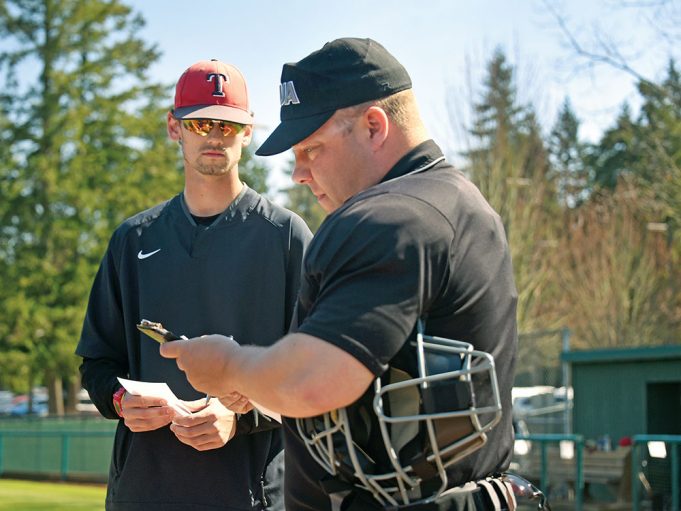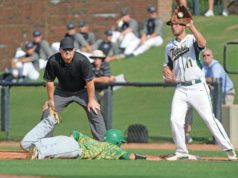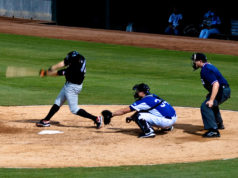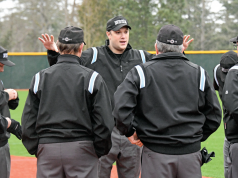College baseball will feature several new wrinkles during the 2021 season as a result of rule changes approved by the NCAA during the offseason.
The rule changes were first proposed by the NCAA Baseball Rules Committee during the summer and gained final approval from the NCAA Playing Rules Oversight Panel in September.
Referee thanks Randy Bruns, the NCAA secretary/rules editor for baseball, for reviewing the information contained in this article for accuracy. Changes appear in approximate order of importance.
Designated Hitter (7-2)
The NCAA has overhauled its designated hitter rule to more similarly mirror the one used in professional baseball. One exception is the starting pitcher may be co-listed in the lineup as the pitcher and designated hitter. The new rule also requires the designated hitter listed in the starting lineup to bat at least once unless the opposing team changes pitchers or the designated hitter becomes injured or ill before his spot in the lineup comes to bat.
The change is intended to simplify the DH rule while maintaining the flexibility of using the two-way player (pitcher/DH) in the collegiate game.
Play 1: During the pregame meeting with the umpires, team A’s head coach turns in a batting lineup featuring nine batters. Jones is listed as the starting pitcher. Ruling 1: Jones is, by default, also the designated hitter and may be treated as such.
Play 2: During the pregame meeting with the umpires, team A’s head coach turns in a batting lineup featuring nine batters. Jones is listed as the starting pitcher. In the fourth inning, during what should be Jones’ second plate appearance, Smith comes to the plate.
In the next half-inning, Jones again takes the mound. Ruling 2: This is legal. Jones began the game as the pitcher and the designated hitter. Once Smith batted, he became the designated hitter, while Jones remained the pitcher.
Re-entry (5-5k)
The NCAA has established a method of permissible re-entry for a player suspected of receiving a concussion during the course of a game.
A player who exhibits signs, symptoms or behaviors consistent with a concussion must be immediately removed and receive appropriate medical evaluation. However, the player may return to his original spot in the lineup if he is cleared by an appropriate medical professional.
A player may only re-enter the game one time. The temporary replacement player may again participate in the game as a substitute in the same lineup spot only.
If the temporary replacement player is substituted for, that player may not re-enter the game.
If a team has no remaining eligible players, a starter or substitute who has previously participated in the game may replace the injured player.
The change is intended to improve player safety, giving coaches a pathway to have a possibly concussed player evaluated and be able to return to the lineup.
Play 3: Following a collision between batter-runner Walker and first baseman Nelson in the third inning, team B’s coach removes Nelson from the game to receive evaluation for a possible concussion and replaces him with Davis. After receiving clearance from the team’s head trainer, Nelson (a) comes to the plate in the eighth inning in his original position in the batting lineup, or (b) in a different position than the one he occupied at the start of the game. Nelson singles, and the team B coach (c) replaces him with Davis as a pinch-runner, or (d) sends Davis to the plate as the next batter. Ruling 3: Legal in (a) and (c), and not legal in (b) and (d). In (c), once Davis pinch-runs for Nelson, the latter is done and cannot return to the game.
Batter Interference/Uncaught Third Strike (7-11h Note)
On a third strike, not caught by the catcher, if the batter-runner clearly hinders the catcher in his attempt to field the ball, whether the action is intentional or not, the batter-runner is out, the ball is dead and all other runners return to the bases they occupied at the time of the pitch regardless of the number of outs.
If the pitched ball deflects off the catcher or umpire and subsequently touches the batter-runner, it is not considered interference unless, in the judgment of the umpire, the batter-runner clearly hinders the catcher in his attempt to field the ball.
The change is intended to simplify the administration of the rule regardless of the number of outs and whether the batter-runner’s action is intentional or not.
Play 4: With a runner on first base and one out, B3 strikes out on a pitch in the dirt. The ball bounces off the catcher and into the path of B3, who takes two steps and inadvertently kicks the stationary ball away from the catcher. Ruling 4: B3 is out, the ball is dead and R1 must return to first base.
Play 5: With a runner on second base and one out, B3 strikes out on a pitch in the dirt. The ball bounces off the catcher and into B3. The ball falls to the ground, where the catcher picks it up, drops it and fails to make any additional play as R2 reaches third base and B3 reaches first base. Ru1ing 5: R2 is safe at third base and B3 is safe at first. This is not considered interference.
Interference/Thrown Bat (7-11n)
If a whole bat is thrown into fair or foul territory, whether intentionally or not, and it interferes with a defensive player attempting to make a play on the ball, interference shall be called.
The change is intended to establish clearer guidance whether interference has occurred in situations of a fielder attempting to make a play when a bat is thrown in foul territory.
Play 6: B1 hits a pop-up near the plate and throws his bat to the ground (a) in fair territory or (b) in foul territory. The opposing catcher, while trying to make a play on the ball, steps on the bat and falls, and the ball falls to the ground next to him. Ruling 6: B1 is called out for interference in both (a) and (b).
Fight Rule (5-16)
Any team personnel, other than coaches, who leave the dugouts or bullpens to enter the field at the time of a potential altercation or fight shall be ejected. Ejections would carry a one-game suspension, unless the individual physically violates the fight rule.
The change is intended to establish a method and penalty for players who exacerbate altercations and delay the game by leaving the dugout or bullpen at the time of an altercation, in order to prevent further escalations and unsportsmanlike conduct.
Foul Tip (2-37)
The definition for a foul tip has been updated to read, “A batted ball that goes sharp and direct from the bat to the catcher and is legally caught. It is not a foul tip unless caught, and any foul tip that is caught is a strike, and the ball is in play.”
The change clarifies that a foul tip no longer has to first touch the catcher’s hand or glove before being legally caught.
Play 7: With a 1-1 count and R1 stealing on the pitch, B2 swings and makes contact with the baseball. The ball ricochets off F2’s mask, and (a) F2 catches it, or (b) F1 catches it.
Ruling 7: This is a foul tip and the ball remains live in both (a) and (b).
Pitcher Applies a Foreign Substance (9-2e)
A stronger penalty has been established for a pitcher using a foreign substance on the ball, and/or having one on his person or in his possession. The penalty is ejection from the game.
If the pitcher expectorates on his hand, ball or glove or rubs the ball on his glove, person or clothing and, in the judgment of the umpire, the pitcher did not intend to alter the characteristics of the baseball, the umpire may warn the pitcher in lieu of an ejection. However, if the pitcher persists in violating the rule, the umpire shall eject the pitcher from the game.
Force Play Slide Rule (8-4)
The updated rule clarifies the force play slide rule does not apply to the batter-runner at first base, and also establishes the runner is not required to slide until in the vicinity of the base.
Live Ball (6-1g)
The rule has been re-written to read, “If a thrown or batted ball that remains in live-ball territory accidentally hits a spectator, authorized onfield personnel or an animal, the ball is live.” There is also a note added that reads, “If a pitched ball strikes a bird in flight or other animal on the playing field, the pitch is nullified, and play shall be resumed with the previous count.”
The changes are intended to distinguish the difference between a thrown or batted ball inadvertently hitting an animal or authorized onfield personnel and a pitched ball striking an animal.
Play or Attempted Play (2-67b)
An additional definition for the term “play or attempted play” has been added to identify that it shall be interpreted as a legitimate effort by a defensive player who has possession of the ball to retire a runner. The fact the runner is not out is not relevant, and a fake or feint to throw shall not be deemed a play or an attempted play.
The rationale for the new wording is there are references throughout the playing rules regarding when a play has occurred, but no definition of what defines a play.
One Foot in Catcher’s Box (9-3i)
The rule has been modified to state the catcher must have at least one foot in the catcher’s box until the pitcher begins the pitching motion.
The change is intended to provide a more enforceable playing rule for umpires depending on where the catcher sets up to receive a pitch.
The Windup (9-1a)
The first sentence of the rule has been changed to read, “The pitcher shall stand facing the batter, his pivot foot in contact with the pitcher’s plate and other foot free.”
In the windup position, a pitcher is permitted to have his “free” foot on the rubber, in front of the rubber, behind the rubber or off the side of the rubber. The pitcher may not take a second step toward home plate with either foot in his delivery of the pitch.
The Set (9-1b)
The first sentence of the rule has been changed to read, “The set position shall be indicated when the pitcher stands facing the batter with his pivot foot in contact with, and his other foot in front of, the pitcher’s plate, holding the ball in both hands in front of his body and coming to a complete stop.”
An additional paragraph has been added to read, “With a runner or runners on base, a pitcher will be presumed to be pitching from the set position if he stands with his pivot foot in contact with and parallel to the pitcher’s plate, and his other foot in front of the pitcher’s plate, unless he notifies the umpire that he will be pitching from the windup position under such circumstances prior to the beginning of an at-bat. A pitcher will be permitted to notify the umpire that he is pitching from the windup position with an at-bat only in the event of (1) substitutions by the offensive team; or (2) immediately upon the advancement of one or more runners (i.e. after one or more baserunners advance, but before delivery of the next pitch).”
Rules for Scoreboards, Video and Audio (Appendix B, A.3 and Appendix D, A.4)
An unlimited number of replays may now be shown at regular speed or slow motion only after a play is under video review and no replays shall be shown once a decision has been made by the umpires and/or replay official.
Also, a stadium videoboard may now play live video upon contact with the bat after the pitch. Live video must cease once a student-athlete enters the batter’s box and may resume upon contact with the bat after the pitch.
Getting the Call Right with Video Review, Coach’s Challenge (Appendix E, 2)
If a coach’s challenge is successful in overturning a call, the coach will retain the challenge to use if needed later in the game.
Visual Inspection/Bat Testing (Appendix G)
The new Appendix G includes guidelines for NCAA bat testing beginning with the 2021 season.
Divisions II and III will be exempt from the compression testing requirement of the bat testing process until the 2022 season. All bats used in competition must undergo a visual inspection and be marked as approved with a destructible sticker.
What's Your Call? Leave a Comment:
Note: This article is archival in nature. Rules, interpretations, mechanics, philosophies and other information may or may not be correct for the current year.
This article is the copyright of ©Referee Enterprises, Inc., and may not be republished in whole or in part online, in print or in any capacity without expressed written permission from Referee. The article is made available for educational use by individuals.



















